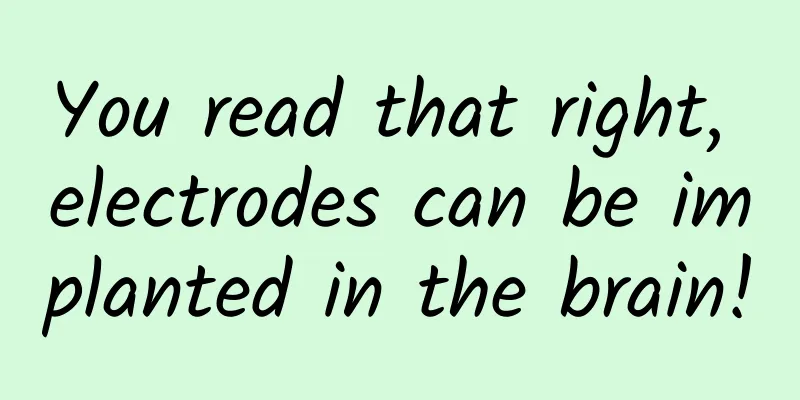You read that right, electrodes can be implanted in the brain!

|
Produced by: Science Popularization China Author: Ishimiya Producer: China Science Expo Can you imagine? In the future, with just a needle, electrodes can be implanted in the brain, and with the help of some medical methods, the symptoms that plague the lives of patients with neurological diseases can be solved. This seemingly far-fetched idea may be one step closer to success. In a recent publication in the journal Science, scientists successfully implanted electrodes in the brains of living organisms, giving people hope that technology can change their lives once again! brain (Photo source: Veer Gallery) How to implant electrodes in the brain? So, how do scientists achieve the positioning and installation of conductive electrodes in living organisms? Scientists have formulated a multi-component mixture gel, which contains non-toxic ingredients. When the mixture gel is injected into the body, the endogenous enzymes around the neural tissue in the body will catalyze the precursors in the mixture to undergo a series of oxidative polymerization and cross-linking reactions to generate ion-electron mixed conductive polymers, and finally form a uniform soft electrode that is stable in the body for a long time. Electrode formation process (Image source: Reference 1) Scientists injected the gel into the zebrafish's head, tail fin, heart and around the leech's nerve tissue, and found that when the gel came into contact with natural molecules in the body, the change in its own structure caused conductivity in the body. This electrode will not harm the body's tissues, nor will it cause the body's immune rejection reaction. Simply put, scientists have developed a gel that is harmless to organisms and is not rejected by organisms. After entering the body, this gel can generate conductivity through structural changes. This method successfully positioned the conductive material around specific nerve tissue in the body, creating a suitable interactive interface for nerve stimulation. With the further development of science and technology, it is entirely possible to create integrated electronic circuits in the body! Electrodes formed in vivo (Image source: Reference 1) What other "high-tech" can be implanted in the body In addition to implanting electrodes near nerves, there are other "high-tech" devices that can be implanted in the human body, bringing good news to people in need. Neural implants In order to alleviate the inconvenience caused by neurological dysfunction to the human body, the U.S. Department of Defense and the National Institutes of Health have invested a lot of money in the research of neural implants. Neural implants are special devices that can interact with and sense neurons in the human body. When we think or remember, the neurons in our brain are activated and emit pulse waves that can be recorded by the implant. Therefore, the implanted device can well record the specific activities of the nerves in the brain. Based on this, external control of the nervous system can be achieved. Through this technology, memory can be improved, brain nerve dysfunction can be reduced, etc. Brain memory (Photo source: Veer Gallery) Artificial Heart The heart is the driving force that keeps people alive. Once the heart is diseased, it will directly affect people's survival. Fortunately, there is a magnetic levitation artificial heart, which brings hope to more heart disease patients. The artificial heart is similar to a loudspeaker worn around the waist. It is less than 3 cm thick, 5 cm in diameter, and weighs less than half a pound, making it very portable. The working principle of the artificial heart involves the characteristics of permanent magnets and electromagnets. Through the effective regulation of the two, the blood pump volume is reduced. In addition, the researchers successfully made the artificial heart compatible with the blood in the body, thus solving the problems of in vitro rejection and thrombosis. However, there is one thing that needs special attention. The artificial heart needs to be charged at all times. Once the power is cut off, it will be dangerous to human life, so it is necessary to ensure that the power is not cut off in daily life. heart (Photo source: Veer Gallery) Conclusion The development of modern science has helped us realize many seemingly unrealistic ideas and helped people suffering from diseases see new hope. I believe that with the further development of science, the "high-tech" implanted in the human body will have more stable and powerful functions, which can truly benefit mankind and further realize the change of life by science and technology. References: [1] Strakosas, Xenofon; Biesmans, Hanne; Abrahamsson, Tobias; et al. Metabolite-induced in vivo fabrication of substrate-free organic bioelectronics. Science, 2023, 379, 6634, 795-802. [2] Fang Siyuan. Research on the support characteristics of centrifugal magnetic levitation heart pump[D]. Wuhan University of Technology, 2012. [3] Yang Dan, et al. Implantable neural microelectrodes. Materials Review. 2020, 34(01). Editor: Guo Yaxin |
<<: Fight against counterfeiting! These fake dining tables have made me suffer!
>>: International Consumer Rights Day丨“Free XX”, is it really free?
Recommend
7 copywriting templates for information flow ads, teach you how to hit the pain points!
With so much information flowing around, how can ...
Meizu feels so wronged, Samsung stops selling 8895 chips, Meizu is suddenly confused
Some time ago, the Samsung 8895 chip was released...
This is how they spent their 90-day "space trip"...
Recently, Shenzhou XII astronauts Nie Haisheng, L...
What should I do if my mobile phone number is bound to someone else in Kuaishou? How to recover Kuaishou account?
This article mainly introduces what to do if your...
It has been prevalent recently, so be extra careful!
Recently, the high temperature and high humidity ...
Will weather outside the Earth affect human life? | World Space Week
Throughout the ages, with a desire to explore the...
APP activity promotion and operation: Create these 3 emotions to warm up the activity
"Wolf Warrior 2" grossed over 1 billion...
Chen Changwen talks about entrepreneurship: Entrepreneurship is all about traffic (electronic document)
Course Catalog: Chen Changwen: The creation of th...
It’s time to spend ten minutes clarifying the definition of product operations
Product operation is the process of attracting a ...
User pyramid model: Zhihu promotion case analysis
As the proposer of the user pyramid model, Lei Le...
A comprehensive summary of promotion channels in 2019!
With the rapid rise of the Internet, there are to...
Searching for the unique blue sky on Earth
Glaciers are the "royalty" of nature Th...
How can enterprises operate new media related to party building?
Nowadays, more and more companies have begun to o...
Vanguards descend from the sky: airborne troops to safeguard national security
Airborne troops are troops that use aircraft as t...
When did female astronauts appear on the historical stage? What advantages do they have in exploring space?
In every manned space flight mission, female astr...









